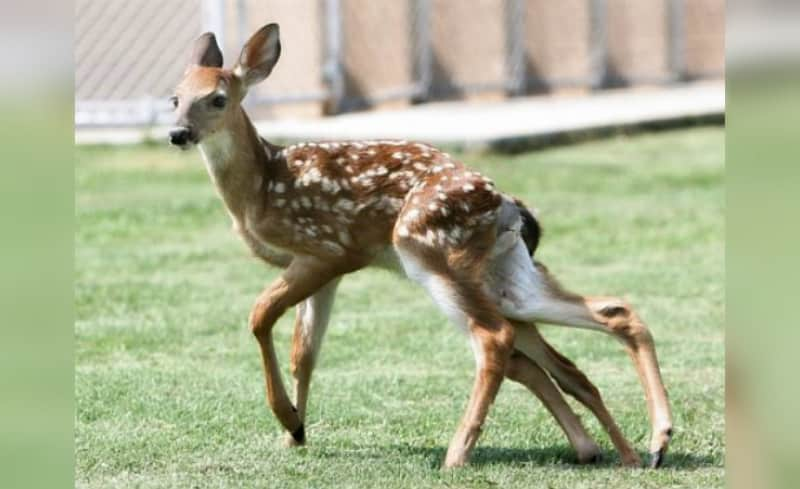9 Shocking, Naturally-occurring Wildlife Deformities
Daniel Xu 01.28.16

These animals didn’t just break the mold, they grew extra legs and decided to stomp it to pieces. No, they’re not mutants. All the animals on this list have deformities that are completely natural, and sometimes even survivable—but they’re probably pretty uncomfortable.
Here are nine animals that will take your breath away at first glance.
1. Mountain lion with teeth in the side of its head

This yearling cougar was harvested earlier this year in Idaho. What made it unique is the teeth that seems to be growing out of the side of its head. If you aren’t sure what causes teeth to grow out of your face, don’t be too surprised—biologists aren’t too sure, either. The most popular theory is that the teeth are the result of a rare tumor called a teratoma, which contains hair, bones, and sometimes teeth. The teeth could also be from the remnants of a conjoined twin or an incredibly severe jaw injury.
2. Elk hoof deformity caused by bacteria

Washington is having a problem with its elk population, and it looks like this. A mysterious illness is turning elk hooves into what essentially look like giant claws.
While the disease has been reported since the mid-1990s, sightings of infected elk have skyrocketed since 2008. Biologists initially believed that the illness was caused by anything from malnutrition to toxicity to metabolic irregularities, but recent test results from four separate laboratories confirmed that Treponema bacteria was indeed the culprit. The disease causes elk hooves to become twisted and overgrown, and can even cripple an animal.
We’re not sure if we like elk looking like giant crabs. Actually, we’re pretty sure the answer is no.
3. Two-headed bull shark

A fisherman made a strange haul in the Florida Keys a few years ago when one of the bull sharks he caught birthed a twin-headed offspring. The fisherman kept the creature and later shared it with scientists who were researching dicephalia, the medical condition of having more than one head. It is believed to be the first instance of such a phenomenon in bull sharks.
4. Six-legged deer fawn

This brings to mind the Norse deity Odin’s eight-legged horse, Sleipnir. Of course, this fawn only has six legs, two of which are believed to have belonged to an absorbed twin. It also had two tails as well, and two pelvises. The deer was first brought to veterinarians after it was attacked by a dog several years ago. It was treated for its injuries and later taken to a deer facility in Georgia. Unfortunately, we don’t know what happened to it since 2008, as the deer appeared to have stayed out of the public eye.
Maybe somewhere there’s a six-legged buck in The Peach State?
Watch a video of it below:
5. Unicorn deer

These are no mythological animals, but they’re still pretty rare. Only a handful of these unicorn-shaped antlers have been found so far, with at least one in Washington state. According to experts, injuries sustained early in the life of the buck can cause it to grow misshapen antlers, some of which will merge into a singular horn-like shape. You can read more about the science behind unicorn deer here.
6. Wolf with spinal deformity

We’re not even sure if this one is real. The pictures are reportedly from a Russian wolf hunter, who harvested this wolf with a severe spinal deformity. Essentially, it looks smushed, like some kind of wolf accordion. If the picture is real, we’re not really sure how it survived for so long.
7. Double-mouthed bream

Who needs two heads when you can just have two mouths instead? Double the food without having to argue with a permanent bodymate. This bream was caught by a fisherman in South Australia and has a rare condition called diprosopus, which is a congenital disorder that causes a part of the face to be duplicated elsewhere on the head.
8. Cactus buck syndrome

Hunters who have never seen a so-called “cactus buck” may be utterly bewildered the first time they spot one of these strange deer. These bucks show no interest in mating, sometimes have the body of a doe, and perhaps most notably, have cactus-like growths where their antlers should be.
These are what hunters call “cactus bucks.” The term is a catch-all for a certain type of antler deformity, but “true” cactus bucks are animals suffering from lowered testosterone production, which in turn affects growth of their antlers. Generally, this is caused by injury to the testicles, which are a major producer of testosterone. Other causes can include tumors or even diseases like epizootic hemorrhagic disease (EHD), which can damage the buck’s testicles or otherwise affect hormone production.
9. Sleigh hoofed moose

Is that moose walking on slippers? No, as it turns out, those strange curved things on its feet are actually its own hooves. An Anchorage resident recently took the photo above of a moose with what appears to be “sleigh hoof” syndrome, a symptom of copper deficiency or an overabundance of other minerals.

